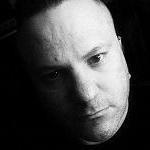Just who is this coffee guy anyway?
So you want to know a little bit more about me, eh? Okay, we'll start with my STUFF. After all, a man is defined by his belongings, right? (Wry grin...)
Any blurb about my STUFF must be default start with music stuff, so read on, but I'll warn you now - if you're not a musician and a techie to boot, it's gonna be a dry read full of meaningless mumbo-jumbo.
- My guitars:
- Jem777VBK - pickups:
- DiMarzio PAF Pro HB
- Jem SC
- DiMarzio PAF Pro HB
[*]RG-550 body w/Jem7RB neck - pickups:
- DiMarzio Tone Zone HB
- Duncan Classic Stack SC
- DiMarzio Air Norton HB
[*]The Old Grey Beast - str*t-style mahogany body w/bubinga top, Ibanez Blazer neck - pickups:
- Fender Noiseless Tele set - subject to change
[*]Gretsch G5120 - modifications:
- Gotoh Delta 510 locking 21:1 tuners
- Compton aluminum bridge
- Maple bridge base, dyed black
- Fretboard dyed black
- Chrome Gretsch B6C "V-cut" Bigsby
- Dice knobs - they can be bought but it's cooler if you make 'em!
[*]Ibanez AEG20E acoustic-electric
[*]Tokai acoustic
- DiMarzio PAF Pro HB
- Jem777VBK - pickups:
[*]Amplification & effects:
- Shure PGX14 wireless system
- Sabine RT-1600 rack tuner
- dbx 166XL compressor/limiter/gate
- Morley Classic Wah
- Ibanez Weeping Demon Wah
- DeltaLab TD1 Tube Driver
- ModTone Speedbox XL distortion
- Ibanez TS-9 TubeScreamer
- Boss CE-2 Chorus
- ModTone MT-AD Analog Delay
- Electro-Harmonix LPB-1 Booster
- Digitech DSP128+
- Peavey 6505+ 120 watt head
- Peavey 6505 4x12 cab
- ART X-12 MIDI controller
- Line 6 Pod 2.0, upgraded to 2.3 firmware
- Epiphone Valve Junior 5 watt head - heavily modded
- Epiphone Valve Junior 1x12 cab
- Gallien-Krueger 250ML Series II
- Custom 2x12 cab, Fender OEM speakers, wired mono/stereo
[*]Recording:
- M-Audio Delta 66 & Omni IO interface
- Steinberg Cubase SX 2
- Steinberg Groove Agent
- Steinberg D'cota
- misc. VSTi soft synths and VST plugins
[*]Other:
- Shure Beta58 dynamic mic
- Sennheiser e609 dynamic mic
- Livewire SPDI direct box
- M-Audio AudioBuddy mic pre
- Slides:
- Dunlop 'Blues Bottle' slide
- Dunlop brass slide
- Dunlop curved pyrex slide
- Bigheart Queen Bee ceramic slide
- Craftsman 11/16" deep-well socket
- Dunlop 918 Jerry Byrd tone bar
[*]Capos:
- Kyser Quick-Change capo
- Paige capo
- Dunlop elastic capo
[*]mic stands, guitar stands, etc.
[*]miles of cable, hundreds of adapters, etc.
[*]the usual assortment of tools, gigging necessities, etc.
[*]Rock 'N Roller cart, various cases, duffels, gig bags, etc.
- Dunlop 'Blues Bottle' slide
Notes regarding my rack/pedalboard setup:
When used with the amps which have an effects loop, channel 1 of the dbx is in front of the preamp, immediately after the tuner; from there any effects intended to be used in front of the amp are connected - typically wah, overdrive and chorus. Channel 2 is in the effects loop and triggered by sidechaining to channel 1, effectively silencing all gain-stage hum. The DSP128+, used for delays & reverbs, the ModTone delay, and LPB-1 are after the gate prior to returning to the amp's power section.
When used with amps which have no loop, channel 1 of the dbx is routed directly to channel 2 - redundant, yes, but it has no ill effect - followed by delay, boost & DSP128+, which then goes to the amp's input.
Ideally, the ModTone delay would come before the DSP128+, as usual routing is delay followed by reverb; however this would involve an additional send & return from the pedalboard, as the LPB-1 tends to wreak havoc on anything that follows it. Fortunately, I rarely use reverb and delay together, and for those instances I can use the DSP128+ for both. For certain applications, I have built a box which allows me to switch, for all intents and purposes, an insert point in or out of the signal path between the chorus and delay.
All sends and returns are handled by a custom snake which carries MIDI, channel switching, and effects send & return in front of preamp and in the loop, as well as power for the pedalboard. Phantom power over MIDI is injected by a custom power brick in the rack, and separated in a custom regulated power brick for pedalboard which can also use an external AC power supply. This eliminates the need for AC drops at the front of the stage, as well as potential noise issues emanating from use of multiple circuits, while the option for external power means I can use the pedalboard without the rack and not have to rely on batteries - something I spend enough on due to the wireless.
So...that sums up the gear entry; keep an eye open for some pictures and stay tuned for more!
-m



0 Comments
Recommended Comments
There are no comments to display.